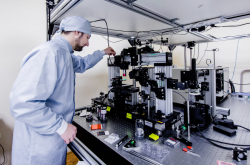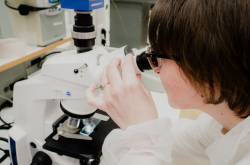St. Petersburg government award
Every year, St. Petersburg’s government awards 20 prizes for achievements in the field of education; this year, 66 different projects participated in the chance to win the award. The award for scientific support of young specialists’ training in the field of physics of metamaterial went to the team from ITMO’s International Research Center for Nanophotonics and Metamaterials, namely Pavel Belov, Dean of Faculty of Physics and Engineering, Irina Melchakova, head of the international laboratory “Applied Radioengineering”, and Constantin Simovski, leading research fellow at the Department of Nano-Photonics and Metamaterials.
“In our application, we described how we have succeeded in forming a modern scientific school, the International Research Center for Nanophotonics and Metamaterials, in less than 10 years. It all began with a small research team, then we launched the Metamaterials laboratory, then - the Department of Nanophotonics and Metamaterials, and now we already have the new Faculty of Physics and Engineering. From the very beginning, we organized everything in such a way that students would be engaged in real research projects from the first or at least the second year of their programs. In other words, we’ve always been focusing on training future scientists,” comments Irina Melchakova.
Today, 90% of all of the Faculty’s publications are written with the help of students who actively participate in research work. The overall number of publications by both staff members and students has greatly increased, as well. The level of magazines the articles get published in has also increased. According to one of the world’s most cited physicists Yuri Kivshar, while in 2010 ITMO scientists strived to get published in such magazines as Physical Review Letters, now they send their articles to Nature or Science straight away.

The Faculty’s students actively participate in international scientific conferences and win awards. Thanks to the Faculty’s established international connections, the students have an opportunity to do internships in Australia (The Australian National University), Finland (Aalto University), and other countries. The International Research Center for Nanophotonics and Metamaterials collaborates with 20 universities from all over the world, and employs 19 foreign scientists. What is more, students regularly get grants and awards from the Russian government, scientific foundations, and international research organizations. Amongst the students are recipients of SPIE and MTTs Scholarships. By March 2018, the center has 43 grants.
Presidential grants
Presidential grants are awarded to early-career researchers or postdocs for a term of two years for conducting fundamental and applied research in the fields included in the in the list of priorities of the Scientific and Technological Development Strategy of the Russian Federation. Their projects have to contribute to the emergence of technologies that will be used as a base for new innovative products and services on Russia’s internal and external markets. Amongst such fields are IT, robotics, artificial intelligence, power industry and energy efficiency, personalized medicine, sustainable product development, and security. Three of ITMO University’s young scientists received the presidential grant this year.
Ivan Iorsh, head of the international laboratory of light-coupling in nanostructures, received a grant in the field of Physics and Astronomy for his research project “Quantum metasurfaces in strong light-matter interaction regime”. Despite the fundamental nature of the research, it will allow to create integrated optical chips. It is aimed at solving one of photonics’ fundamental problems - the low level of nonlinear response in optical systems, i.e. that photons aren’t prone to interacting with each other. This hinders the development of metasurface-based optical gates, though they offer many opportunities in regard to controlling the propagation of light on a nanoscale.

“The possible solution for the problem lies in the introduction of the so-called strong light-matter interaction regime. This way, the photon is “mixed” with the material excitation of the media (in our case - an exciton bound by an electron-hole pair), that interact with each other well. This way, we can indirectly attain a really high level of optical nonlinearity even in common waveguides. If we were to introduce such a regime in metasurfaces, where nonlinearity is amplified due to the localization of the electromagnetic field, that would’ve made possible to create optical gates of small capacity. What is more, we can hope to observe new quantum-optical effects systems with a high level of optical nonlinearity,” comments Ivan Iorsh.
Andrei Bogdanov, research associate at the Department of Nanophotonics and Metamaterials, got a presidential grant in the field of physics and astronomy for his research project “Surface electromagnetic waves in dielectric and plasmonic nanostructures”. The project is dedicated to studying the fundamental problems of modern information technology. According to the scientist, finding the solution for the project’s tasks will supposedly make it possible to take data transfer and processing technologies to the next level. Amongst other things, the project aims to answer the question of the efficiency of using surface waves localized on dielectric and plasmonic nanostructures for transferring and processing optical signals within the framework of a single microcircuit chip.

“As of today, optical fibre is being successfully used for transferring information via an optical signal. It is thanks to that we have fast and cheap internet access. A full-fledged substitution of computer chips and electrical wires with optical ones will help decrease energy consumption and make it possible to process information tens of times faster,” explains Andrei Bogdanov.
Sergei Kovalchuk, Associate Professor at the High-Performance Computing Department, received a grant for his “Methods and technologies of managing complex models with the use of surrogate modeling approaches”. This research is of a fundamental nature, and is aimed at studying the possibility of automating the management of complex models of different systems. Two cases will be used for the research project. The first is modeling of the water level of the Baltic Sea used for predicting floods, which is essential in terms of St. Petersburg’s safety. The second is modeling of the processes of treating the patient stream within the framework of departments of a specialized medical center, as processes in medicine and healthcare are associated with a very high level of uncertainty.

Still, these cases are just two examples of the possible application of the approaches in question. On the whole, predictive models can be used in many fields, including urban planning, development of smart cities, social studies, and the like.
“Our research’s results will make it possible to solve the tasks of managing composite systems on a whole new level. We will develop common approaches, methods and algorithms for automating modeling processes for both research purposes and as part of automated and automatic management systems, recommendation systems, decision support systems and other systems that make use of modeling results. For our project, we’ll be using surrogate modeling, machine learning, evolutionary and cloud computations and automated modification of models with regard to initial data. Automating model generation will make their adjustment and application a lot easier,” comment Mr. Kovalchuk.





